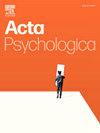Impact of artificial colored lights on performance in working memory task
IF 2.1
4区 心理学
Q2 PSYCHOLOGY, EXPERIMENTAL
引用次数: 0
Abstract
The contemporary lifestyle obligates exposure to artificially illuminated environments often with a variation in spectral composition of light. The wavelength of light, perceived as the color, differentially stimulates the short, medium, and long wavelength cones. Through the non-image-forming pathways, light possibly affects cognitive functions including working memory. Commensurately, this warrants an evaluation of the effects of exposure to colored lights of specific wavelength, on the performance in cognitive task. A within-subject approach was planned to ascertain the impact of light in white, red, green, and blue wavelengths (corresponding to the retinal cone cells) on performance in the Forward Digit Span Task (FDST) and Backward Digit Span Task (BDST) in four randomized sessions. Each light exposure session was preceded by 15 min of dark state and performances were assessed using percent accuracy. The mean age of participants (N = 50) was 28.8 years. A statistically significant difference was found in performance in FDST (P < 0.0005) and BDST (P < 0.0005) with exposure to different colored light (specific wavelengths) when compared to white light (broad-spectrum). Performance in FDST was better than the performance in BDST in all light conditions. The results suggest that working memory performance was affected by the color of light and performance in DST was better under red light than other lights. Therefore, the color of light plays an important role in cognitive performance and ambient light color needs to be adjusted while testing cognitive functions. Red lights may enhance memory recall compared to blue and green lights.
人造彩色灯光对工作记忆任务表现的影响
当代的生活方式要求暴露在人工照明的环境中,光线的光谱组成经常发生变化。光的波长,被认为是颜色,不同地刺激短、中、长波长视锥细胞。通过非图像形成途径,光可能影响包括工作记忆在内的认知功能。相应地,这需要评估特定波长的彩色光对认知任务表现的影响。研究人员计划采用受试者内部方法,确定白、红、绿、蓝波长的光(对应于视网膜锥细胞)对四组随机受试者在前向数字跨度任务(FDST)和后向数字跨度任务(BDST)中的表现的影响。每次光照之前都有15分钟的黑暗状态,并使用百分比准确率评估表现。参与者的平均年龄(N = 50)为28.8岁。两组患者FDST的表现差异有统计学意义(P <;0.0005)和BDST (P <;0.0005),与白光(广谱)相比,暴露于不同颜色的光(特定波长)。在所有光照条件下,FDST的性能都优于BDST。结果表明,工作记忆的表现受光的颜色的影响,其中在红光下工作记忆的表现优于其他光。因此,光的颜色在认知表现中起着重要的作用,在测试认知功能时需要调整环境光的颜色。与蓝灯和绿灯相比,红灯可能会增强记忆。
本文章由计算机程序翻译,如有差异,请以英文原文为准。
求助全文
约1分钟内获得全文
求助全文
来源期刊

Acta Psychologica
PSYCHOLOGY, EXPERIMENTAL-
CiteScore
3.00
自引率
5.60%
发文量
274
审稿时长
36 weeks
期刊介绍:
Acta Psychologica publishes original articles and extended reviews on selected books in any area of experimental psychology. The focus of the Journal is on empirical studies and evaluative review articles that increase the theoretical understanding of human capabilities.
 求助内容:
求助内容: 应助结果提醒方式:
应助结果提醒方式:


